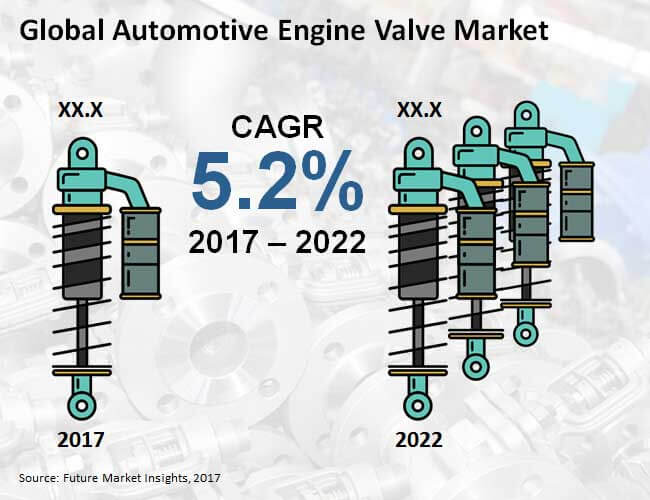Future demands for automotive engine valves will be firmly driven by trends such as reduction in exhaust emissions and oil consumption, declining sulphur content in diesel fuel, and phasing out of leaded petrol. Such factors may create implications in production and design of automotive engine valves. Leading automakers will also seek newer materials for manufacturing engine valves with higher durability and greater sustenance to heat. With increasing adoption of alternative fuels, future requirements of automotive engine performance will change the dynamics of valve manufacturing.

An exclusive forecast report published by Future Market Insights anticipates that the global automotive engine valves market will soar at a steady CAGR of 5.2% during the forecast period, 2017-2022. The report also assesses that automotive engine valves worth over US$ 6.2 billion will be sold globally by the end of 2022. The steady demand for automotive engine valves will be factored by their essentiality in proper functioning of automobile engines, and their influence in enhancing the vehicle’s performance under diverse conditions.
Request a Sample of this Report @ https://www.futuremarketinsights.com/reports/sample/rep-gb-3473
Although, hollow valves will register a below-average demand over the next five years
While the overall sales of automotive engine valves will be incurring a steady demand through 2022, the demand for hollow valves is likely to dwindle. Compared to bimetallic and monometallic valves, hollow valves will be garnering low uptake owing to their conventional drawbacks. Tests show that performance of engines equipped with hollow valves gets lowered when hollow valve stems absorb more heat than threshold. The tendency of hollow valves to overheat and burn in the absence of adequate cooling continues to factor their declining demand. Over the forecast period, hollow valves are anticipated to reflect a subpar CAGR of 4.7%, indicating a moderate growth in demand.
We Offer tailor-made Solutions to fit Your Requirements, Request Customization@ https://www.futuremarketinsights.com/customization-available/rep-gb-3473
Market Taxonomy
A concise taxonomy of the global automotive engine valve market has been summarized in the table below:
Region
- North America
- Latin America
- Europe
- Japan
- APEJ
- MEA
Product Type
- Mono metallic valves
- Bimetallic valves
- Hollow valves
- Others
Vehicle Type
- Compact Passenger Cars
- Mid-sized Passenger Cars
- Premium Passenger Cars
- Luxury Passenger Cars
- Light Commercial Vehicles
- Heavy Commercial Vehicles
Material Type
- Steel
- Titanium
- Nickel Alloy
- Other Materials
Sales Channel
- OEM
- Aftermarket
Direct Purchase of this Report@ https://www.futuremarketinsights.com/checkout/3473
Key insights offered in the report
- In 2017, monometallic valves being sold in the global market will reap over US$ 1.5 billion in revenues
- Compact passenger cars will be observed as a leading vehicle segment in the market, followed by mid-sized passenger cars and light commercial vehicles
- Titanium materials are forecasted to incur sluggish CAGR through 2022
- By 2022-end, aftermarket sales of automotive engine valves will bring in revenues worth over US$ 5 billion, globally
In 2017, Europe is poised to procure nearly one-fourth share of global revenues. The report also projects that the Asia-Pacific excluding Japan (APEJ) region will be the largest market for automotive engine valves. By the end of 2022, the APEJ automotive engine valve market is anticipated to reach a value of US$ 2.2 billion. North America’s automotive engine valve market is also expected to soar at a steady CAGR, while sales of automotive engine valves in Japan will reflect a moderate growth.
Changing landscapes of automobile engineering will continue to foment considerable alterations in the manufacturing of automotive engine valves. New designs will be reviewed and tested, while conventional valves will be upgraded for boosting their performance abilities. The report observes that companies namely, Knorr-Bremse AG, FTE automotive GmbH, Hitachi Ltd., FUJI OOZX Inc., Mahle Group, Eaton Corporation Plc., Federal-Mogul Holdings Corp., Denso Corporation, Continental AG, and Delphi Automotive PLC will remain active in expansion of the global automotive engine valve market through 2022. These companies are anticipated to capture new materials and innovative production techniques to insure the valves from their existing defects.